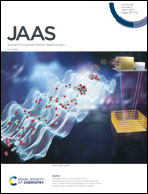Increased sensitivity in proton-transfer-reaction time-of-flight mass spectrometry by using a novel traveling wave based ion-molecule reactor†
Abstract
Proton-transfer-reaction time-of-flight mass spectrometry (PTR-TOFMS) has proven to be more and more essential in online monitoring technologies of volatile organic compounds (VOCs). A key component in the PTR-TOFMS instrument is the ion-molecule reactor (IMR), which traditionally generates a continuous ion current. However, TOFMS cannot fully detect the continuous ion beams generated by the traditional IMR because the acceleration of the ions in the pusher region is discontinuous. In this work, a novel traveling wave ion-molecule reactor (TW-IMR) for the PTR-TOFMS has been developed for the first time. Before entering the TOFMS pusher, the ions were trapped in the TW valley of TW-IMR. Subsequently, the TOFMS pulse was adapted to synchronize the time of the ion packet arriving in the repulsion region and the pusher. In order to evaluate the performance of the TW-IMR-TOFMS instrument, a series of typical VOCs such as acetone, benzene, toluene, xylene, and styrene were used. Depending on the compound, the limit of detection (LOD) was significantly improved by a factor of 8 to 22 when switching from asynchronous to synchronous operation. Moreover, TW-IMR-TOFMS performed better than conventional PTR-TOFMS in terms of LOD by 3–18 times. Different aspects and characteristics of TW-IMR, such as the effects of TW speed, TW amplitude, TW duty cycle, RF amplitude, and TW-pusher delay times upon the formation of the reagent ions, were explored systematically. As a result, the proposed TW-PTR-IMR technique not only improved the ion usage in the TOFMS without introducing an additional pulse lens but also enhanced the ion transmission efficiency compared to the traditional PTR-IMR by combining it with the RF ion focusing technology. Benefiting from the advantages of the TW technology, the proposed TW-IMR-TOFMS technology opens up a new avenue for increasing the performance of the existing PTR-TOFMS methods.



 Please wait while we load your content...
Please wait while we load your content...